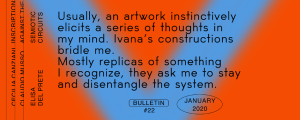On show the winners of the 2016 Villa Romana Prize
The current exhibition at Villa Romana features artwork by this year’s winners of the Villa Romana Prize: Flaka Haliti, Stefan Vogel, Nico Joana Weber, and Jonas Weichsel. The show is divided into three rooms.
The concept for one room was made by Stefan Vogel and Nico Joana Weber together, whereas Jonas Weichsel and Flaka Haliti exhibit in seperated rooms.
Entering Weber and Vogel’s room, you step on cement slabs that cover the original mosaic pattern on the floor. Being a bit bumpy, these stone slabs force you to watch your steps, thus turning your gaze on the photographs, collages and drawings embedded in the cement until you arrive at the walls where the other works by Stefan Vogel are displayed: “Ach – sowieso – genau —” (2015), and the series “Wissen wohin”, composed of 12 pieces. Just like he does with his works embedded in cement, for the work displayed on the wall he used different materials. In form of collages, the artist contextualizes words, yarn, and several different papers. While looking at his work, which almost appears as a story, you feel like standing in the rain, as intended by the artist. This feeling is conveyed by speakers placed on different angles of the room, that reproduce the “rain-like” sound of Nico Joana Weber’s film “Unstable landscape” (2016). The film analyses the relation between architecture and tropic vegetation in South America: for instance, how nature succeeds to insinuate themselves into buildings, by showing Le Corbusier’s Casa Crutchet in Argentina. During the course of the film the boundaries between indoors and outdoors grow indistinct, until they finally are deactivated. The film can be seen as a parallel to Weber’s other film “Markasit”: shot at the Ruhr-University in Bochum, the film deals with its architecture and contrasting surroundings, by starting inside the building and then leading outwards.
Flaka Haliti exhibits her video “I Miss You, I Miss You, till I Don’t Miss You Anymore” (2012-2014). Several letters written by couples in long-distance relationships (the artist herself and from her circle of friends) are translated into English by an online tool, and read aloud by a monotonous computer voice, that underlines a failure in the communication of love. According to her, 95% of long-distance relationships fail, due to migration and mobility, as she experienced herself, living in several cities: Pristina, Frankfurt, Munich – and recently Florence. Three different screens and three different colors represent three different stages of relationships.
In the third room, Jonas Weichsel exhibits his two paintings “TC Single 2” and “TC Single 3”, both from 2016 and both following the same design. At a first glance, the paintings might seem like prints to the observer, due to their abstract precision. Different layers of color, applied with a custom-built brush, interact with each other to form a relief. Even if not visible, the artist has a name for every part of the painting, which can be retrieved also in his other works of the same series.
Flaka Haliti, Stefan Vogel, Nico Joana Weber, and Jonas Weichsel (Fellows 2016), 2016 Villa Romana Prize, Villa Romana, Firenze, through April 29, 2016
by Roberta Faust
in Focus on Europe
Apr 21, 2016



























